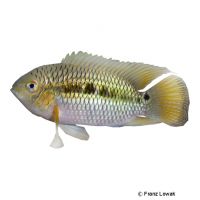Dimerus Cichlasoma (Cichlasoma dimerus)
| Dimerus Cichlasoma Cichlasoma dimerus | |
|---|---|
| Name | Dimerus Cichlasoma |
| Name Lat. | Cichlasoma dimerus |
| Synonym | Aequidens dimerus |
| Family | Cichlids |
| Family lat. | Cichlidae |
| Order | Cichlids |
| Order lat. | Cichliformes |
| Origin | South America |
| Habitat | Rivers |
| Diet | Omnivore |
| pH | 6.5-7.5 |
| Behavior | Semi-aggressive |
| Keeping | Pair |
| Care Level | Easy |
| Reproduction | Substrate spawner |
| Breeding | Moderately difficult |
| Life Span | 8-10 years |
| Protection | No |
| Metric Units | |
| Size | 11 cm |
| Temperature | 23-27 °C |
| Hardness | 2-15 °dH |
| Aquarium | 100 cm / 200 l |
| US Units | |
| Size | 4.3" |
| Temperature | 73-81 °F |
| Hardness | 36-267 ppm |
| Aquarium | 50 gal |
Distribution and habitat
The Dimerus cichlids are widespread in the Rio Parana and Rio Paraguay basins. They live in the shore areas of rivers with clear water, where they find numerous shelter and hiding places, such as roots, branches and dead wood.
Maintenance
They need a well-structured aquarium with a robust border planting, numerous hiding places (stone structures, roots) and a lot of swimming space. A dark, sandy substrate covered with some foliage (sea almond tree, oak), slightly subdued light (floating plants) and a weak current is ideal.
No ammonia, ammonium and nitrite should be detectable, the nitrate value should not exceed 100 mg/l. To ensure water quality and oxygen content, a filter and heater adapted to the aquarium size is required, as well as lighting for the species-appropriate day-night rhythm of the animals.
Diet
The food supply consists of high-quality dry food for cichlids (pellets, granules), supplemented with live or frozen food, such as artemia, mysis, tubifex and red mosquito larvae or a commercially available, frozen special food mix for cichlids. In addition, they occasionally need vegetable food, such as spinach, algae leaves or dry food with high vegetable content (spirulina).
Only feed as much as is eaten immediately (in a maximum of 10 minutes). Regular and varied feeding promotes health and increases resistance.
Behaviour and compatibility
They are calm and peaceful fish, even towards conspecifics, which should be kept in pairs. Only at spawning time they behave somewhat territorial. They can be socialized well with other larger fish. Fish that are too small are considered prey.
Basically, only compatible fish species with similar demands on water condition and water temperature should be socialized.
Sex dimorphism
Females remain somewhat smaller and do not have as elongated fins as males, whose forehead area may be more convex, especially in older animals. With some experience, the sexes can be distinguished in adults by their genital papilla, which is pointed in the male and smaller and flat-ending in the female.
Reproduction and breeding
They spawn on shallow stones or roots (open brooders). Both parents engage in brood care (parental family). After two days the larvae hatch and swim free after another 4 days. The young fish are protected by the parents for some time and are led to the feeding places in the aquarium before the brood care ends.
Fry must be fed several times a day with special rearing food (Artemia nauplii). Breeding is hardly possible in community tanks, where the fry are easy prey.
Important
The Dimerus cichlids quickly become trusting
The well-being of the fish should be checked regularly. Temperature should be checked daily, pH, hardness and nitrate levels at least fortnightly. Regular partial water changes are recommended, even if the contaminant level has not yet reached the upper limit. Sudden changes in water quality should be avoided. Newly introduced fish must be accustomed slowly to the water in the aquarium.
Further literature can be found in your pet store.
References
Text: Werner Winter; Image: Franz Lowak
Source: BMELV (1998): Tierschutzgutachten - Haltung von Zierfischen (Süßwasser); RIEHL & BAENSCH (2004): Aquarien Atlas Bd. 3, Mergus Verlag; ENGELMANN (2005): Zootierhaltung - Tiere in menschlicher Obhut: Fische, Verlag Harri Deutsch
- Gemäß § 21 Abs. 5 Tierschutzgesetz idgF
